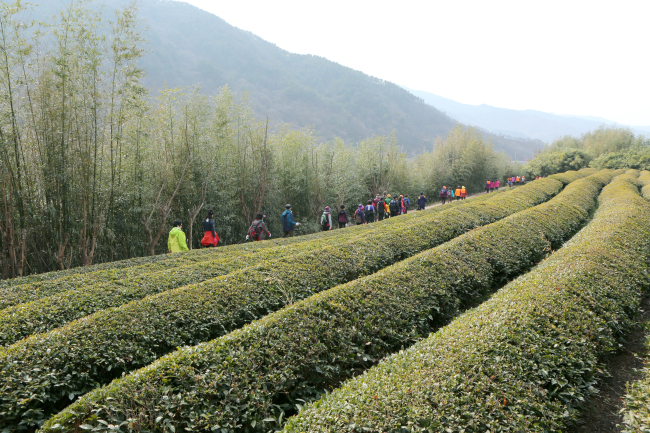This is the first installment of a four-part series introducing Korea’s springtime tourist destinations. ― Ed.
With the cool breeze of winter behind us and the start of Korea’s prime spring season, many people want to break free from their daily lives and visit hot tourist spots.
But for quick weekend getaways, a long line of cherry blossoms on sidewalks aren’t the only things to see when the young finish their rigorous school exams and older citizens file their last business documents.
The Korea Tourism Organization suggests six locations where visitors can not only see natural landscapes, but also take in the unique cultural works of state-designate craftsmen this month.
At Deoksan, Yesan, about a two-hour drive south of Seoul, tourists have a chance to meet and see the works of the 78-year-old master carpenter Jeon Heung-soo, who is also the director of the Korea Traditional Architecture Museum.
 |
Tourists walk through a tea garden in Hadong, South Gyeongsang Province. (KTO) |
There may only be miniature building models displayed at the site, but the small versions ― one-fifth or one-10th the size of the country’s national treasures such as the Sungnyemun, one of Seoul’s fortress gates, and the Palsangjeon Buddhist Temple ― have been recognized for their delicate craftsmanship.
They have been made with the same techniques and materials used by the construction industry, which make them almost real for visitors. Also, the tourism agency said the models offer visitors, including architecture students and enthusiasts, a chance to learn about their history, carpentry and modeling.
People can roam freely inside and outside the museum to check out numerous models of traditional buildings, temples and palaces. But KTO officials recommend a guided tour offered by curators to hear the stories about their making and uniqueness.
For people looking for a greener getaway, about four hours away from Seoul, tourists can visit the vast land of wild green teas in Hwagae, Ha-dong in South Gyeongsang Province.
Among many tea gardens in the region, one can’t miss Hwagaejeda, which is run by 86-year-old state-designated master Hong So-sul, who spent most of his life raising tea leaves and making tea for consumers.
Every May, Ha-dong holds a tea festival where visitors can taste a variety of green teas and learn about their history, which dates back to the Silla dynasty. As the story goes, a Silla envoy brought tea seeds from China’s Tang, which was ordered by the Silla’s King Heondeok to plant the seeds in Mount Jirisan in Hwagae in the year 828.
Meanwhile, in Jindo, South Jeolla Province, which is known for a variety of traditional food and cuisine, tourists can see and taste special rice cakes made from mushrooms used in traditional Asian medicine.
Kim Young-suk, Korea’s traditional food master, uses mushrooms that grow on the roots of pine trees to create the rice cakes, or medicine cakes, which can enhance the digestion of elders and children alike.
If traditional lacquerware grabs your interest, head to Wonju, Gangwon Province, where the late master Kim Bong-ryong dedicated his life to creating the decorative ware with mother-of-pearl materials.
Tourists can see Kim’s works at the Wonju Lacquer Culture Center and the Wonju Municipal Museum, the Korean tourism agency said. The region also holds an annual festival showcasing lacquerwares from artists and craftsmen nationwide.
For more information on the KTO’s recommended travel sites for April and the Ministry of Culture, Sports and Tourism’s 100 tourist attractions, visit: korean.visitkorea.or.kr and www.mustgo100.or.kr.
By Park Hyong-ki (
hkp@heraldcorp.com)








